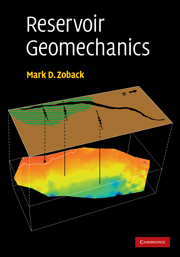11 - Critically stressed faults and fluid flow
Published online by Cambridge University Press: 10 December 2009
Summary
In this chapter I consider three topics related to fluid flow in fractured and faulted oil, gas and geothermal reservoirs. First, I consider the influence of fractures and faults on reservoir permeability with the associated implications for permeability anisotropy within a fractured and faulted reservoir. Second, I consider geomechanical controls on fault sealing and leakage in fault bounded reservoirs. Finally, I consider dynamic constraints on hydrocarbon column heights and reservoir pressures, again in fault bounded reservoirs. A common element of the discussions of these three subjects is fluid flow along critically stressed faults. As discussed in Chapters 4 and 9, the fact that the state of stress in many reservoirs is found to be controlled by the frictional strength of optimally oriented faults has important implications for fluid flow at a variety of scales.
Each of the topics considered in this chapter is of considerable practical interest during the development of oil, gas and geothermal reservoirs. In reservoirs with low matrix permeability, there might be no significant fluid flow in the absence of permeable fractures and faults. Moreover, it is frequently the case that relatively few fractures and faults serve as the primary conduits for flow (Long et al. 1996). The question, of course, is to know which of the fractures and faults that might be present in a reservoir are most likely to be hydraulically conductive and why.
- Type
- Chapter
- Information
- Reservoir Geomechanics , pp. 340 - 377Publisher: Cambridge University PressPrint publication year: 2007
- 7
- Cited by



